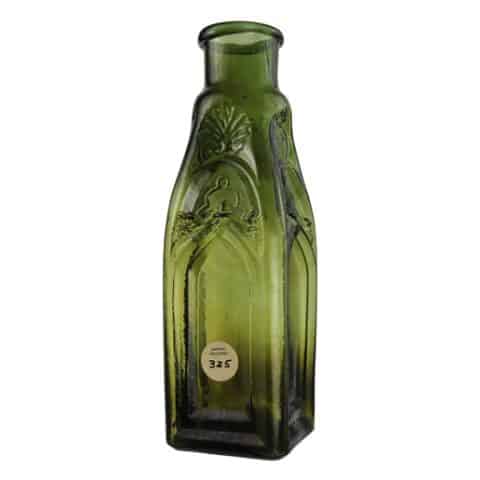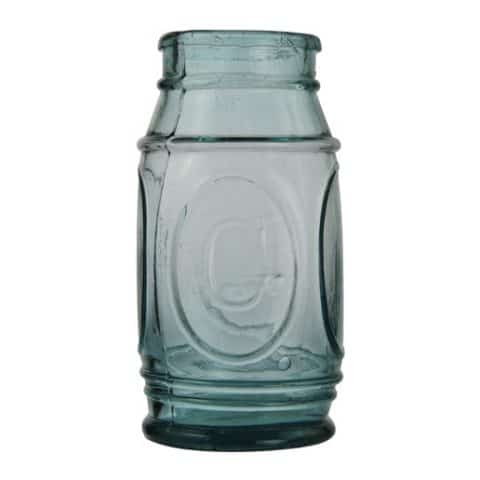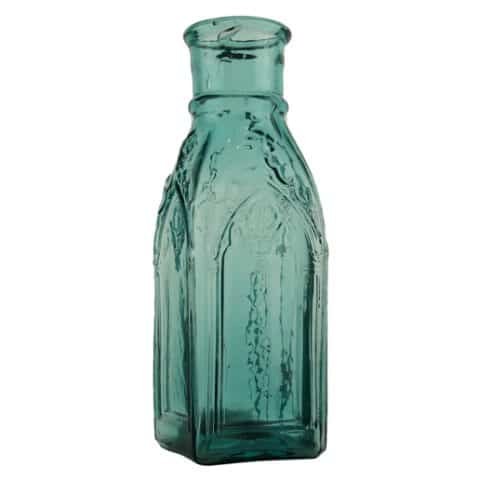Wells Miller & Provost Fancy Pickle
Wells Miller & Provost
Fancy Pickle Jar
John B. Wells, Ebenezer Miller & Stephen H. Provost, New York City, N. Y.
Medium Teal Pickle Jar
Provenance: Lou Pellegrini Collection

The Wells, Miller & Provost fancy pickle jar is one of the most sought after bottles and brands in the Foods & Sauces category in our museum.
This wonderful medium-teal jar is square with beveled corners and fluted shoulders. There is an outward rolled lip that sits on a wide neck and base ring. There are four (4) indented horizontal arched areas above four (4) chamfered vertical radiused rectangular label panels on each of the bottle sides. Within the first arch is embossed ‘WELLS,’ the second arch has ‘MILLER’, while the third arch has ‘PROVOST.’ Between Miller and Provost is an embossed ‘&’ on the side bevel that separates the two names. The fourth arch is blank. The 12-inch tall bottle, with an iron pontil, is in excellent condition and exudes character.

John Babcock Wells was born in New York City in September 1812. He was the second son and child of George and Mary (Babcock) Wells. He was one of twelve children which included six sons and six daughters. Both his parents were from old Connecticut stock.
Wells secured an ordinary common school education. One of his first jobs was being an apprentice to learn the trade of chair-painting. During this apprenticeship, when to him a shilling was a large sum, he learned the habits of prudence and economy which followed him throughout life.
Soon after attaining his majority (or perhaps a little before) John Wells, in company with his elder brother George Jr., succeeded his father George in the pickle and preserve business, who had his store on Water Street, near the United States Hotel. George Wells Sr. had been in the grocery business since 1805 or so, much of the time at the 194 Water Street address. The new grocery partnership in 1833 was G. & J. B. Wells at the same address.
In 1835, John Wells married Hannah L. Miller from Stamford, Connecticut. They had five daughters and one son John who would later die in the Battle of Antietam in September 1862. In the early 1850s, Hannah would die and John would marry his second wife, Adeline Rowland. They had two sons and two daughters.
After a few years, John’s brother George moved on as John B. Wells was listed as a grocer on Water Street from 1836 to 1839. A partnership with Ebenezer Miller, John’s brother-in-law from Stamford, Connecticut, developed in 1841. A listing in Longworth’s American Almanack, New-York Register, and City Directory for 1842 read, “Wells & Miller, pickles, 194 Water, 242 Front.” Sometime around 1844, Stephen H. Provost joined the business that was renamed Wells, Miller & Provost. This is the name embossed on our subject bottle.

By 1849, Wells, Miller & Provost were advertising their Compound Extract of Blackberry. By 1852, they had expanded and were located at 215 & 217 Front Street and 52 Tompkins. They were prominently advertising pickles and had become one of the most prolific manufacturers and distributers of embossed bottles for that period.

Ebenezer Miller died in the mid to early 1850s and Wells & Provost was formed at No. 321 Pearl Street in New York City. So prosperous were they in business, that on the death of Ebenezer Miller, a few years after, his widow received over $41,000, as his share of the business.
Wells & Provost were the proprietors of Spratt’s Patent July 18, 1854 Self Sealing Can for Preserving Fruits, Vegetables &C. Their main warehouse was located on 215 & 217 Front Street in New York. Advertising said, “Wells & Provost, Dealers in Pickles, Preserves, Preserved Provisions, &C., Proprietors of the Amakassi Preserving Works, also of the Mount Vernon Pickle Works and the Nepperham River Plantation Works.

In 1854, the company expanded to the west coast when D. R. Provost, the son of Stephen was sent to San Francisco, California. He established a western outlet for their products, and even filed a trademark in October 1863 for a ‘concentrated vinegar.’
Wells & Provost continued in business until 1863 when from ill health and other causes, John B. Wells sold out his interest to his partner, and Stephen Provost continued alone. Wells would die on April 23, 1872.
See the museum examples of Wells Miller & Provost fancy sauce bottles.

Primary Image: Wells Miller & Provost teal fancy pickle jar imaged by the FOHBC Virtual Museum west coast studio by Gina Pellegrini.
Support: Reference to American Bottles and Flasks and Their Ancestry by Helen McKearin and Kenneth M. Wilson, Crown Publishers Inc., New York, 1978.
Support: Reference to Ketchup Pickles Sauces – 19th Century Food in Glass by Betty Zumwalt
Support Image: Wells, Miller and Provost’s Compound Extract of Blackberry Created advertisement, c1849. – Library of Congress
Support Image: Full-page advertisement, Wells & Provost, Amakassi Preserving Works. 215 & 217 Front Street, New York. Published by D. Bigelow & Co., Boston 1856.
Support Image: Auction Lot 118: “Wells / Miller / & / Provost.” Fancy Pickle Jar, America, 1840-1860. Square with beveled corners and fluted shoulders, aquamarine, outward rolled lip – pontil scar, ht. 12 inches. Z pg. 128 Beautiful early pickle jar with lots of whittle and brilliant glass clarity. – Norman Heckler, Norman C. Heckler Auctions
Support Image: Auction Lot 106: “Wells Miller & Provost.” Pickle Jar, America, 1840-1860. Cylindrical with fluted shoulders and rings and diamonds around base, aquamarine, applied sloping collared mouth – pontil scar, ht. 11 inches; (light exterior high point wear). Similar to Z pg. 428 An attractive mold which is not listed in Betty Zumwalt’s book. Fine condition. Glenn Quimby collection. – Norman Heckler, Norman C. Heckler Auctions, Auction #170
Support Image: Four (4) Wells, Miller & Provost pepper sauce bottles. Two (2) 9″ and two (2) 8″ bottles. – Photo from the Charles and Jane Aprill collection.
Join the FOHBC: The Virtual Museum is a project of the Federation of Historical Bottle Collectors (FOHBC). To become a member.















































